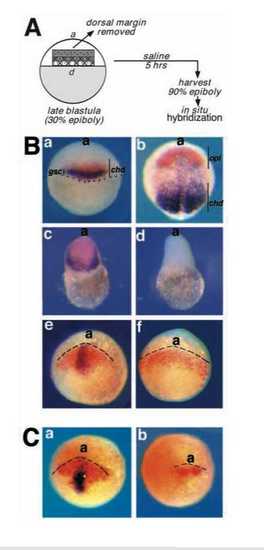
Dorsal mesendoderm is required for the gastrula expression of opl. (A) Schematic outline of the extirpation experiment. The dorsal margin of a late blastula embryo, morphologically distinct from the ventral margin at 30% epiboly, was removed by microdissection. Three distinct regions were removed: the stippled region, corresponding approximately to the chd-expressing region, the hatched region, corresponding approximately to the gsc-expressing region, and the solid gray region, corresonding to the animal portion of the presumptive organizer region. Resulting embryos were cultured until control embryos reached 90% epiboly when they were stained by in situ hybridization (B,C) for genes listed below (see also Results and Materials and Methods). (B) (a,b) Control wild-type embryos; (c,e) control microsurgery; (d,f) removal of the presumptive shield/organizer region. (a) Dorsal view of a wild-type embryo at early gastrula (shield stage) stained for gsc (purple) and chd RNA (orange); (b) dorsal view of a wild-type embryo at late gastrula (90% epiboly) stained for chd (purple) and opl RNA (orange). (c) Embryo generated by removing the animal portion of the presumptive organizer region (solid gray in Fig. 7A), cultured until 90% epiboly stage equivalent and stained for opl (orange) and chd (purple). 5 out of 5 embryos obtained in 1 experiment expressed opl and chd. (d) Embryo generated by complete removal of the presumptive organizer region (stippled in A), cultured until 90% epiboly stage equivalent, and stained for opl (orange) and chd (purple). 8 out of 23 embryos generated in 4 experiments failed to express chd, and were also devoid of opl RNA. The remaining 15 out of 23 embryos expressed chd and opl, probably due to incomplete organizer removal. (e) Mock dissected embryos at 90% epiboly stage equivalent, stained for opl (orange) and gsc (purple). 11 out of 11 embryos generated in 4 experiments expressed both opl and gsc. (f) Embryo generated by removing part of the presumptive organizer region (hatched in A), cultured to 90% epiboly equivalent, and stained for opl (orange) and gsc (purple). 10 out of 17 embryos generated in 4 experiments failed to express gsc, but were able to express and pattern opl. In addition, 1 embryo was obtained which was free of both gsc and opl staining. (C) Analysis of one eyed pinhead mutant embryos. Embryos resulting from a cross between oep te57 heterozygotes (39 total) were analysed at tailbud stage by in situ hybridization for expression of opl (orange) and gsc (purple). (a) Wild-type embryo, representative of 30 out of 39 embryos; (b) sibling embryo homozygous for the oep mutant allele, identified by failure to express gsc (9 out of 39 embryos). opl was patterned but expressed at lower levels.
|

